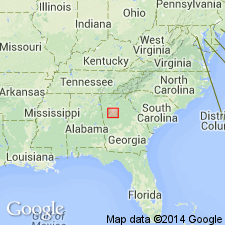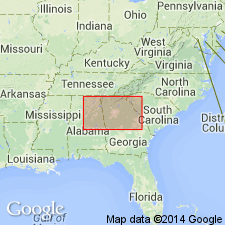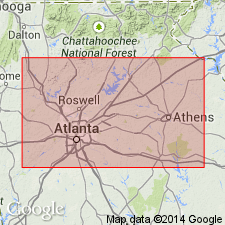
- Usage in publication:
-
- Clarkston Formation*
- Modifications:
-
- Named
- Dominant lithology:
-
- Schist
- Amphibolite
- AAPG geologic province:
-
- Piedmont-Blue Ridge province
Summary:
The Clarkston Formation of the Atlanta Group, here named in the Newnan-Tucker synform near Atlanta, GA, consists of interlayered purple-pink-weathering muscovite schist and ochre-weathering hornblende-plagioclase amphibolite. On the northwest limb of the Newnan-Tucker synform, it is divided into a lower Fairburn Member and an upper Tar Creek Member. Overlies Wahoo Creek or Stonewall Formation with sharp and probably conformable contact. Gradationally underlies the Big Cotton Indian Formation in the northeast; elsewhere underlies the Intrenchment Creek and Camp Creek Formations with sharp and conformable contact. Thickness is 800 to 2,500 m. Age is Late Proterozoic and (or) early Paleozoic.
Source: GNU records (USGS DDS-6; Reston GNULEX).

- Usage in publication:
-
- Clarkston Formation*
- Modifications:
-
- Revised
- Age modified
- AAPG geologic province:
-
- Piedmont-Blue Ridge province
Summary:
The Clarkston Formation is removed from the Atlanta Group, here abandoned. The Tar Creek Member is abandoned because it is identical to the Clarkston Formation undivided. The Fairburn Member occurs in the Clarkston slice of the Atlanta thrust sheet in Georgia. The Clarkston is composed of interlayered schists and amphibolites and grades into the underlying Barrow Hill Formation; underlies the Big Cotton Indian Formation. Age is Late Proterozoic to Early Ordovician(?).
Source: GNU records (USGS DDS-6; Reston GNULEX).

- Usage in publication:
-
- Clarkston Formation*
- Modifications:
-
- Age modified
- AAPG geologic province:
-
- Piedmont-Blue Ridge province
Summary:
Age of Clarkston Formation of the allochthonous assemblage is changed to Late Proterozoic(?) to Middle Ordovician(?) based on a more conservative theory that the allochthonous rocks are 1) probably not older than Late Proterozoic because they are not part of Middle Proterozoic (Grenvillian) basement and 2) they could be as young, but not younger than, the time marking the beginning of closure of the ocean they originated in, as set by the slope reversal marked by deposition of Middle Ordovician Rockmart Slate upon unconformity at top of Upper Cambrian to Middle(?) Ordovician Knox Group and Middle Ordovician Lenoir Limestone. Report includes geologic map and correlation chart.
Source: GNU records (USGS DDS-6; Reston GNULEX).
For more information, please contact Nancy Stamm, Geologic Names Committee Secretary.
Asterisk (*) indicates published by U.S. Geological Survey authors.
"No current usage" (†) implies that a name has been abandoned or has fallen into disuse. Former usage and, if known, replacement name given in parentheses ( ).
Slash (/) indicates name conflicts with nomenclatural guidelines (CSN, 1933; ACSN, 1961, 1970; NACSN, 1983, 2005, 2021). May be explained within brackets ([ ]).

